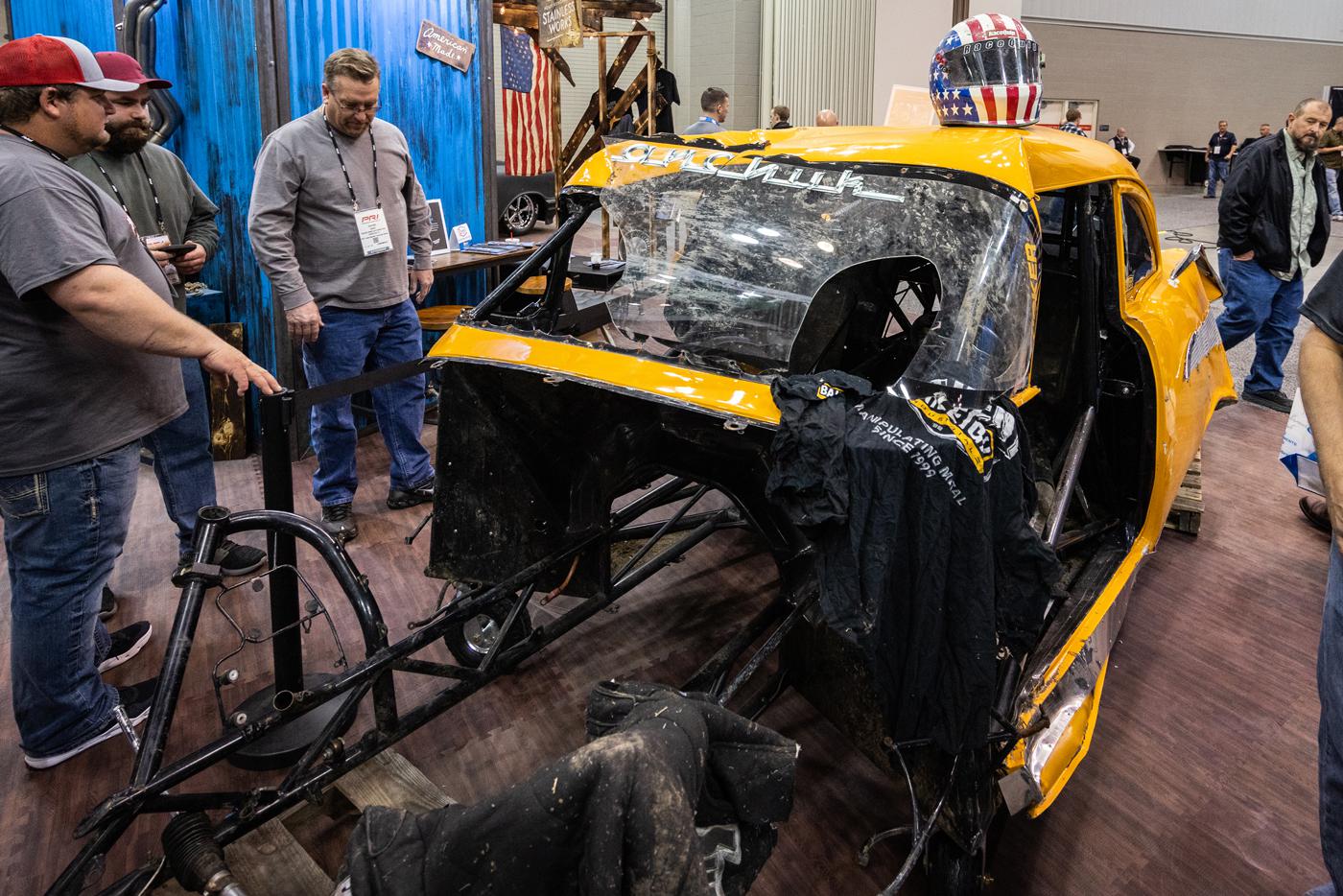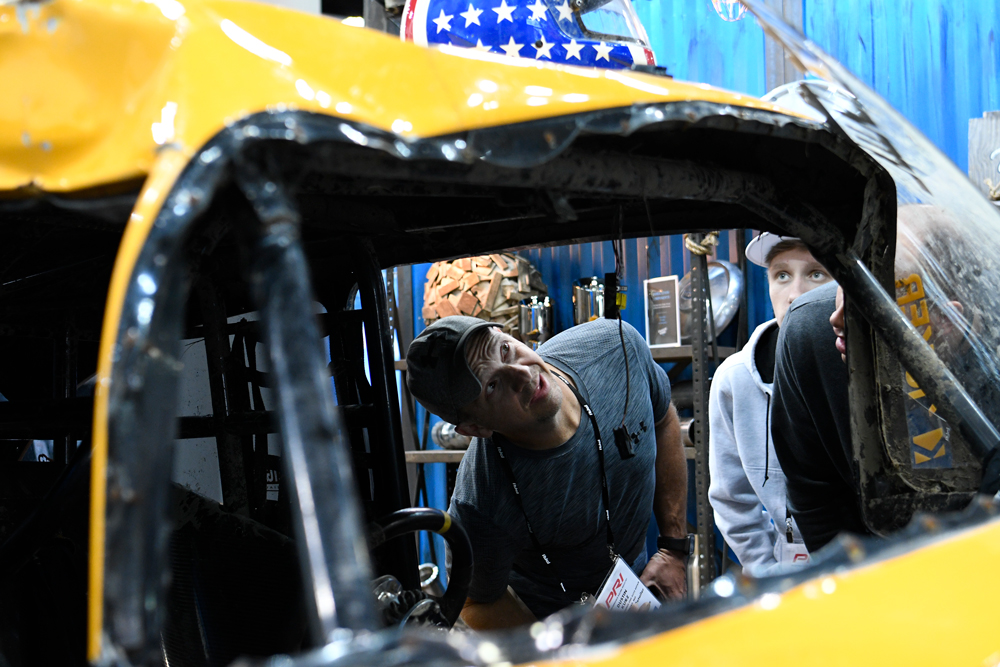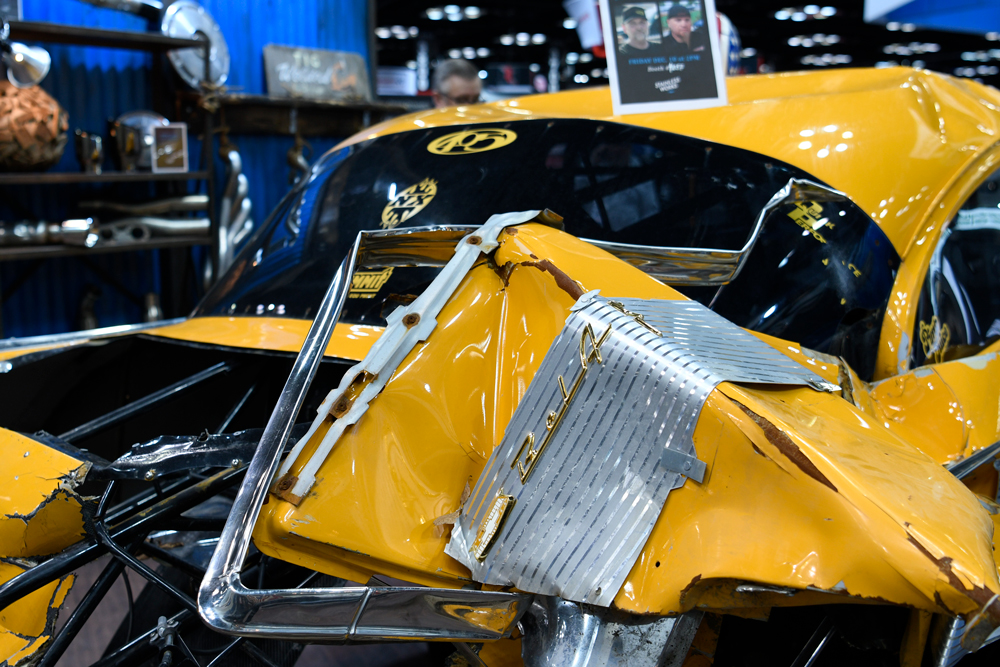YELLOW CRUSH

Jeff Lutz brought the remnants of his prized yellow 1957 Chevy, which sustained point-of-no-return damage during a “Street Outlaws” race in Okemah, Oklahoma, in May, to the PRI Trade Show to illustrate the importance of proper safety equipment in motorsports.
Drag racer Jeff Lutz brought two 1957 Chevys to last year’s PRI Trade Show—a roller that would become his next race car, and the crumpled remains of his famous yellow car. He brought the wreck as a stark example of how proper safety construction and equipment can save a driver’s life—in this case, his own.
In early February, viewers of “Street Outlaws” on Discovery Channel finally saw the footage of the horrendous crash that sent Jeff Lutz to the hospital in May 2021, fortunately with just bumps and bruises. The crumpled and torn yellow 1957 Chevy, which Lutz had built with his son, Jeffrey Jr., looked like it had been used for target practice on a mortar range; the crash that sent the car tumbling at a race in Okemah, Oklahoma, seemed nearly as destructive.
Lutz, who spoke with PRI shortly after the “Street Outlaws” episode aired, said that it was the worst smashup he’d ever been involved in. He is well known in the street-car drag racing world for his “Mad Max” 1969 Camaro that a few years ago won Hot Rod magazine’s Drag Week. The competition requires racers to drive their race cars from track to track, going 1,000 miles over five days. Lutz set a record for a street-legal car with a 5.852-second quarter-mile run at 250.27 mph.
At the 2021 PRI Trade Show, the wrecked ’57 Chevy was displayed in the Stainless Works booth alongside the new ’57 roller Lutz had built by DMC Racing in Halifax, Massachusetts. He and his son completed the car in their Lutz Race Cars shop in Callery, Pennsylvania.
Recalling the crash, Lutz explained that the Chevy had hit a bump at about 160 mph and gone instantly out of control, flipping and rolling to a stop seconds later. He said he had released the chute but acknowledged that even then he knew it was for naught.
“There was nothing I could do at that point,” he explained. “The car went end-over-end and side-over-side. I was just along for the ride.”
Lutz was life-flighted to a hospital. “I didn’t know what was going on for a couple of days,” he said. “I was bruised up around the neck pretty badly. I had neck trauma from the HANS device, but I might have broken my neck without it.”

Before long, Lutz was racing again, driving a 2004 Pontiac GTO built by DMC Racing while the new ’57 Chevy was under construction.
At the PRI Show, the wrecked ’57 stood as an example of the safety he said Lutz Race Cars builds into all its cars. He also wanted it to be a stark reminder that racers need to take safety seriously.
Photographic Proof
The photos of Lutz’s wrecked Chevy tell the story: Safety saves drivers. Note the minimal crush of the roof, and that the cabin remained intact. Lutz’s car retained only its quarter panels and roof skin from an original ’57 Chevy. It was the car’s by-the-book race car construction, and, most critically, its SFI-certified chassis and cage, that protected him.
“The cage saved my life,” he said. “I mirror all my safety on NHRA rules. Our chassis certifications and all of our stuff is up to date. That’s what we do. We built it well, and it saved my life. It was crazy to see the carnage it went through, and all I had were bumps and bruises.”
‘Safety is No Joke’
Lutz pointed out his other safety equipment, including a carbon fiber seat, the harness and helmet from RaceQuip, and a Simpson fire suit. Having spent much of January racing and filming for “Street Outlaws” in South Texas, he saw firsthand the consequences of a crash for an ill-prepared driver.

“There was a guy there who never wore all his safety equipment,” he recalled. “He wasn’t wearing gloves or even a face shield. He crashed, caught fire and got burned on his hands and eyes. His wife was in the next lane. She hit the parked cars and was still in the hospital.”
Lutz’s message to other racers: “Do it by the book. Safety is no joke.”
 MEMBERSHIP LOGIN
MEMBERSHIP LOGIN JOIN PRI
JOIN PRI


